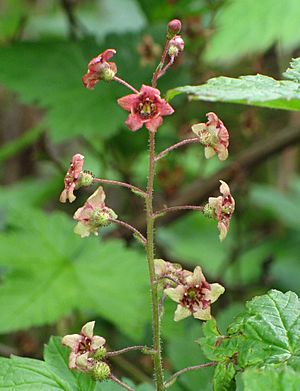Trailing black currant facts for kids
Quick facts for kids Trailing black currant |
|
|---|---|
 |
|
| R. laxiflorum specimen from Joffre Lakes Provincial Park, British Columbia | |
| Scientific classification | |
| Genus: |
Ribes
|
| Species: |
laxiflorum
|
| Synonyms | |
|
Ribes affine Douglas ex Bong. |
|
The Ribes laxiflorum, also known as the trailing black currant or spreading currant, is a type of currant plant. It grows naturally in western North America. You can find it from Alaska and Yukon down to northern California and New Mexico. This plant also grows in Siberia.
It likes damp places like mountain forests and open areas. You might also see it along streambanks or next to mountain roads.
Contents
What Does the Trailing Black Currant Look Like?
The Ribes laxiflorum is a shrub that spreads out and trails along the ground. It usually grows about half a meter to one meter tall (20 to 40 inches). Sometimes, in shady spots with things to climb on, it can grow like a vine. It can reach up to seven meters (23 feet) long!
Its stems are fuzzy and sticky, but they don't have any sharp spines or prickles. The leaves look a bit like maple leaves. They are hairy and sticky, growing up to 10 centimeters long. Each leaf is deeply divided into several pointed sections with dull teeth along the edges.
Its Flowers and Berries
The plant produces groups of up to eight flowers on a stem called a raceme. These flowers are quite unique. They have five parts called sepals, which can be greenish, purplish, or red. These sepals often curve backward at their tips.
In the middle of the flower, there are five tiny red or pink petals. Each petal is only about a millimeter long. They are narrow at the bottom and wider or club-shaped at the top. Inside the petals, you'll find five red stamens. These stamens have whitish tips called anthers.
After the flowers bloom, they turn into fruit. The fruit is a purple-black berry. It measures about four to fourteen millimeters wide. The berries can feel waxy, hairy, or even a bit bristly to the touch.
How People Use This Plant
The berries of the Ribes laxiflorum have been an important food source for many Native American groups. People like the Bella Coola, Haisla, Hanaksiala, Hesquiat, Kwakiutl, Lummi, Makah, Oweekeno, Skagit, and Tanana eat them. They enjoy the berries fresh, boiled, or made into jams.
Traditional Uses
Beyond food, different parts of the Ribes laxiflorum have been used in traditional ways:
- The Bella Coola people would make a special liquid from the roots or branches. They used this liquid as an infusion to help with eye problems.
- The Skokomish people used a Decoction (a strong liquid made by boiling) from the bark and roots. They used it to help with chest issues.
- The Skagit people used a similar liquid from the bark to help with the common cold.
- The Lummi people made a general tonic from the leaves and twigs to help them feel better.
- The Hesquiat people were known to use the woody stems to create pipe stems.

